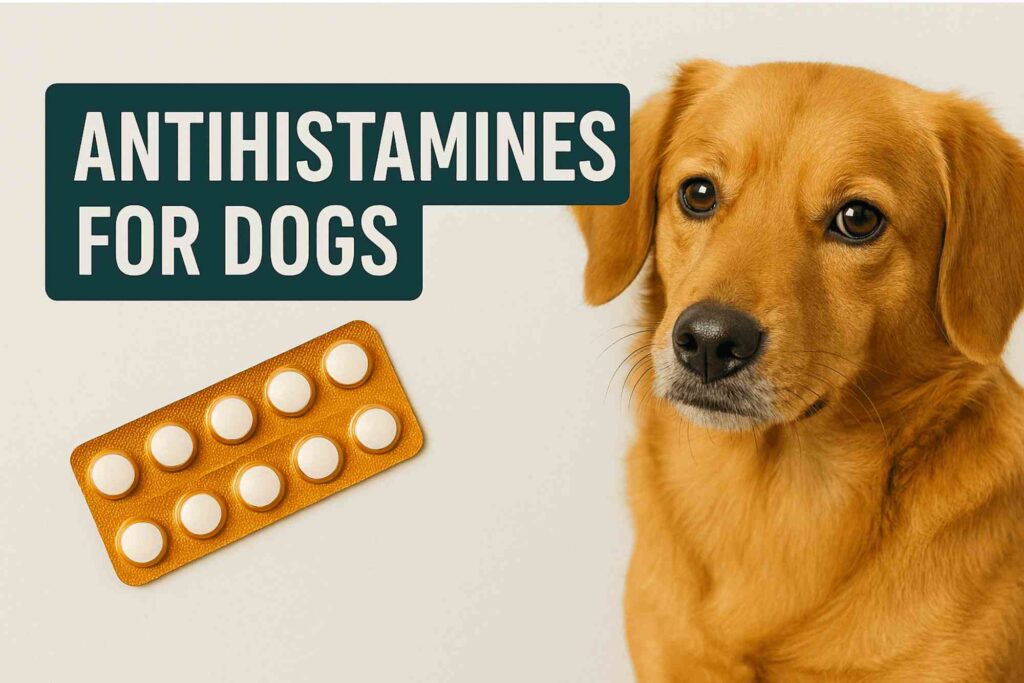The best antihistamine for dogs’ itching depends on several things, such as:
-
Severity of itching
-
Severity of itching
-
The dog’s size, age, and weight
-
Reaction to the medication (effects may vary from dog to dog)
-
Need or avoid sedating effects
-
Cause of itching (allergies, fleas, yeast, etc.)
However, based on veterinary experience and research, considering the following factors, some of the best and most effective antihistamines are listed below in the form of a chart.
| 🐕 Weight / Nature | 🧠 Mood / Attitude | 🐾 Symptoms (nature of itching) | ✅ Recommended Antihistamine | 💡 Notice |
|---|---|---|---|---|
| 1–15 lbs (small dogs) | Sensitive & Delicate | Mild itching & Seasonal allergies | Cetirizine (Zyrtec) | Safer & Less Side Effects |
| 1–15 lbs | Excited & Anxious | Difficulty sleeping & Itching at night | Diphenhydramine (Benadryl) | Sleep-Inducing & Good for nighttime |
| 16–30 lbs (medium dogs) | Peaceful | Red skin & Frequent itching | Hydroxyzine | Effective & Prescription required |
| 16–30 lbs | Active & Outgoing | Flea or dust allergy | Chlorpheniramine | Effective at small weights |
| 31–60 lbs | General mood | Frequent paw licking & Seasonal itching | Levocetirizine | More effective than Cetirizine |
| 31–60 lbs | Avoid sleeping Pills | Itching all day & no swelling | Fexofenadine (Allegra) | Non-sedating & Expensive |
| 61+ lbs (large dogs) | Peaceful & low-energy | Severe allergy & itching with swelling | Hydroxyzine or Clemastine | Effective, but under a doctor’s supervision |
| 61+ lbs | Shouldn’t be drowsy | Itching just from a change in weather | Loratadine (Claritin) | Once a day is enough. |
| Any weight | Any mood | If the medications are not effective | Apoquel or Cytopoint | Modern solutions to control itching |
Dosages of different antihistamine medications:
-
Cetirizine (Zyrtec): One 10mg tablet for each dog weighing 30-40 pounds, twice daily.
-
Loratadine (Claritin): Half a 10mg tablet for every 20 pounds of dog weight, once a day.
-
Clemastine: 1.34mg tablet for each 65-pound dog, twice a day.
-
Diphenhydramine (Benadryl): One 25mg tablet for every 25 pounds of dog, twice a day. May be a sedating agent – may be beneficial for sleep at night
-
Hydroxyzine: One 25mg tablet for every 25 pounds of dog, twice a day (this is a prescription medication)
-
Chlorpheniramine: One 16mg tablet for every 40 pounds of dog, twice a day
-
Fexofenadine: One 100mg tablet for every 50 pounds of dog, twice a day
-
Levocetirizine: One 20mg tablet for every 40 pounds of dog, once per day
What is the antihistamine dosage chart for dogs?
| Generic Name | Brand Name | Dosage (mg per lb) | Frequency | Dose by Dog Weight |
|---|---|---|---|---|
| Diphenhydramine | Benadryl | 1 mg/lb | Every 8–12 hrs | 25 lb dog → 25 mg |
| Cetirizine | Zyrtec | 0.5 mg/lb | Once or twice daily | 20 lb dog → 10 mg |
| Loratadine | Claritin | 0.25 mg/lb | Once daily | 40 lb dog → 10 mg |
| Hydroxyzine (Rx) | Atarax, Vistaril | 1 mg/lb | Every 8–12 hrs | 25 lb dog → 25 mg |
| Chlorpheniramine | Chlor-Trimeton | 0.2–0.4 mg/lb | Every 8–12 hrs | 20 lb dog → 4–8 mg |
| Clemastine | Tavist | 0.02 mg/lb | Every 12 hrs | 65 lb dog → 1.3 mg |
| Fexofenadine | Allegra | 1–2 mg/lb | Once or twice daily | 25 lb dog → 25–50 mg |
| Levocetirizine | Xyzal | 0.25–0.5 mg/lb | Once daily | 20 lb dog → 5–10 mg |
Important tips:
-
Taking Omega-3 Fish Oil with this medication may improve its effectiveness.
-
A 2 to 3 week trial is necessary for each antihistamine to determine its effectiveness.
-
Use the xylitol-free form of medications.
-
Antihistamines are helpful for mild or moderate allergies.
-
If itching is severe or not completely controlled, treatment such as Apoquel, Cytopoint, or steroids may be needed.
-
Always consult a veterinarian for a complete diagnosis.
FAQs
Which human antihistamine is ok for dogs?
Diphenhydramine (Benadryl®), cetirizine (Zyrtec®), and loratadine (Claritin®) are commonly used antihistamines to treat itching and allergies in humans and are considered safe for dogs. Antihistamines are generally safe for dogs, but avoid products with toxic ingredients such as Xylitol, pseudoephedrine, phenylephrine, and Diphenhydramine liquid.
Will antihistamines stop my dog from scratching?
Antihistamines alone will not stop scratching. Your dog may need stronger medications like Apoquel, Cytopoint, or steroids, as well as treatment for any infections or parasites. Antihistamines are safe and worth trying, but Research shows that only about 25–30% of dogs with allergies respond well to antihistamines.
What is the best antihistamine for dogs? Anything that is not a prescription, preferably natural, that works as one?
Antihistamines are not really the best treatment for dogs with allergies. One that is most effective is hydroxyzine, which is available by prescription. When people insist that their vet prescribe an antihistamine because they don’t want to pay for prescription drugs that actually work, veterinarians are more likely to prescribe loratadine. You can call your vet for a dosage for your specific animal.
Is it safe to give your dog antihistamine and antibiotics at the same time?
Giving antihistamines and antibiotics together is generally safe for dogs, but the choice of antibiotic and exact dosing must come from your vet to avoid side effects or resistance. Because both antibiotics and antihistamines can sometimes cause drowsiness, stomach upset, or vomiting so watch for side effects.
Do antihistamines have any side effects for dogs?
Yes, antihistamines can have side effects in dogs. Common Side Effects of Antihistamines in Dogs are Drowsiness, Sleepiness, Dry mouth, increased thirst, Mild digestive upset, Urinary retention and Excitability or hyperactivity.

